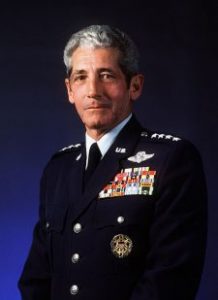 SSS member General Robert Whitman Bazely was born in Pittsburgh, Pennsylvania and flew the F-100 with the 77FBS/20FBW Weathersfield, 55-58; 492TFS/48TFW Lakenheath 65-67; 531TFS/3TFW/CC at Bien Hoa from 68-69.
SSS member General Robert Whitman Bazely was born in Pittsburgh, Pennsylvania and flew the F-100 with the 77FBS/20FBW Weathersfield, 55-58; 492TFS/48TFW Lakenheath 65-67; 531TFS/3TFW/CC at Bien Hoa from 68-69.
He graduated from Brentwood High School in Pennsylvania and enlisted in the US Army in September 1943 and entered active duty through the aviation cadet program in January 1944, receiving his navigator wings and commission as a second lieutenant in the U.S. Army Air Forces in March 1945. He was then released from active duty in February 1946 and returned to Pennsylvania to enroll at the University of Pittsburgh, graduating in 1949. In November 1951 he was recalled to active duty as a result of the Korean War and served as an RB-26 Invader navigator with the 12th Tactical Reconnaissance Squadron at Kimpo Air Base, South Korea, and flew 50 combat sorties. In August 1953 he entered pilot training and received his wings a year later. Following F-84 fighter weapons training, he transferred to Royal Air Force Station Wethersfield, England, where he served as a pilot, flight commander, and assistant operations officer with the 77th Tactical Fighter Squadron.
In May 1958 he returned to the US and was assigned to the 3502nd U.S. Air Force Recruiting Group with duty in Pittsburgh, serving there until June 1960. He then transferred to the US Air Force Academy in Colorado Springs, Colorado. Returning to England in April 1965, he served at Royal Air Force Station Lakenheath as operations officer for the 492nd Tactical Fighter Squadron and later as chief, Operations Division, 48th Tactical Fighter Wing. He returned to the US in 1967 and completed the Industrial College of the Armed Forces at Fort McNair, Washington DC. In August 1968 he was assigned to the 3rd Tactical Fighter Wing, at Bien Hoa Air Base, Republic of Vietnam, serving as commander of the 531st Tactical Fighter Squadron, and flew 257 combat missions in F-100 Super Sabre aircraft.
He returned to the US in September 1969 and served in the Directorate of Operations, Headquarters US Air Force, Washington, DC, and later he joined the Directorate of Operations in the Organization of the Joint Chiefs of Staff. In June 1972 he served as commander of Randolph Air Force Base, Texas (now part of Joint Base San Antonio) and in November 1972 he transferred to Laredo Air Force Base, Texas (now closed), and assumed command of the 38th Flying Training Wing. In October 1973 he commanded the 323rd Flying Training Wing at Mather Air Force Base, California (now closed) and in August 1975 he was assigned to Headquarters US Air Forces in Europe (USAFE) at Ramstein Air Base, Germany as its Inspector General, and in June 1976 he became the command’s Assistant for Readiness. In May 1978 he returned to the US and became commander of the Air Force Inspection and Safety Center at Norton Air Force Base, California (now closed). From July 1979 to June 1980, he commanded Sheppard Technical Training Center, at Sheppard Air Force Base, Texas. He then returned to England as commander of 3rd Air Force at Royal Air Force Station Mildenhall and in July 1981 he returned to Germany as vice commander in chief of USAFE at Ramstein. In July 1983 he returned to the US and became the Inspector General of the US Air Force at Headquarters Air Force, Washington DC, where he was responsible to the Secretary of the Air Force and the Chief of Staff for US Air Force inspection, safety, security, investigative, counterterrorism, counterintelligence and complaint programs.
On November 1, 1984, he was promoted to the rank of general and became the Commander-in-Chief of PACAF at Hickam Air Force Base, Hawaii, and retired in that position on January 1, 1987, with 39 years of active military service.
His military decorations and awards include the Air Force Distinguished Service Medal, the Defense Superior Service Medal, the Legion of Merit with oak leaf cluster, the Distinguished Flying Cross with oak leaf cluster, the Bronze Star, the Meritorious Service Medal, the Air Medal with 15 oak leaf clusters and the Air Force Commendation Medal with oak leaf cluster. He was a command pilot and navigator with more than 4,500 flying hours.
